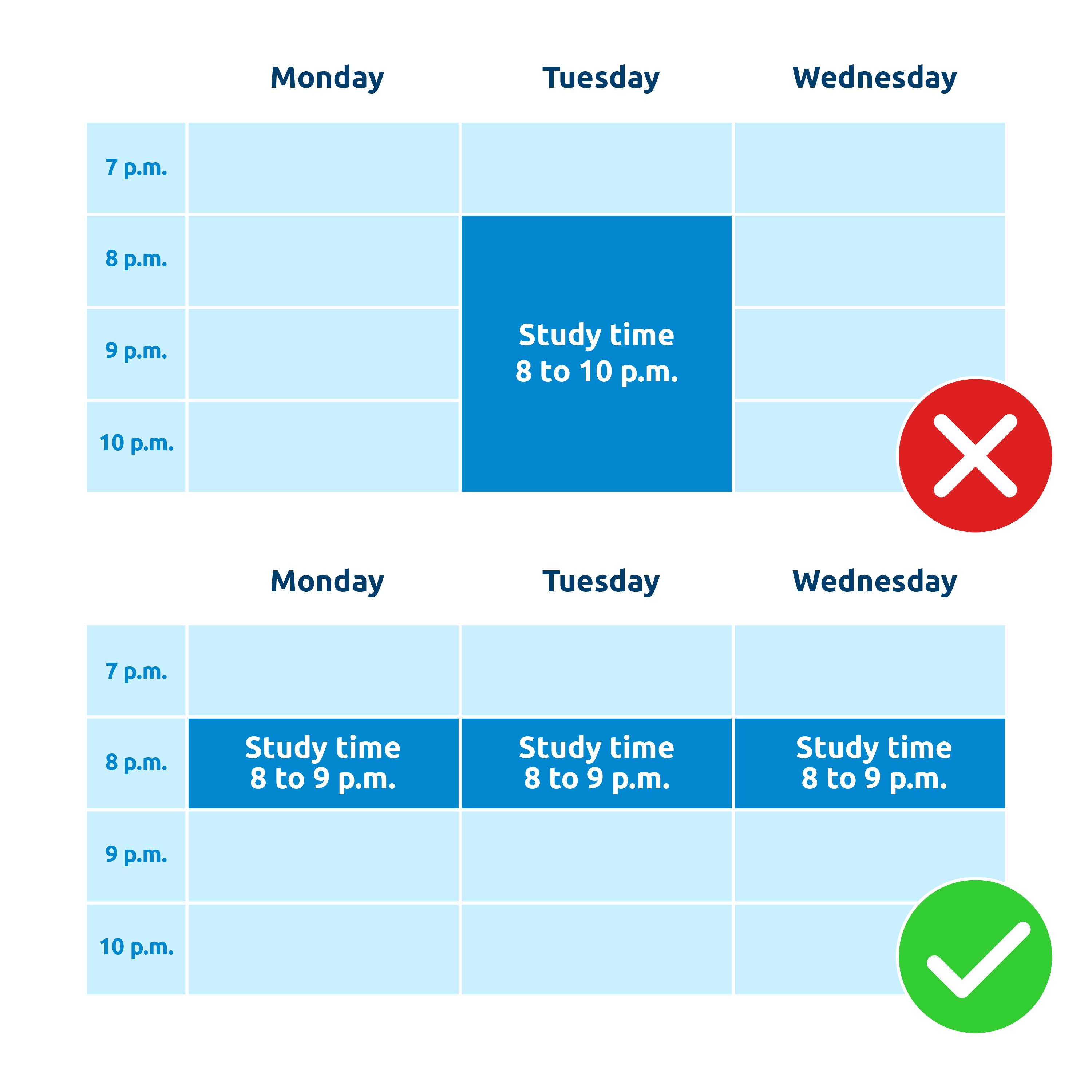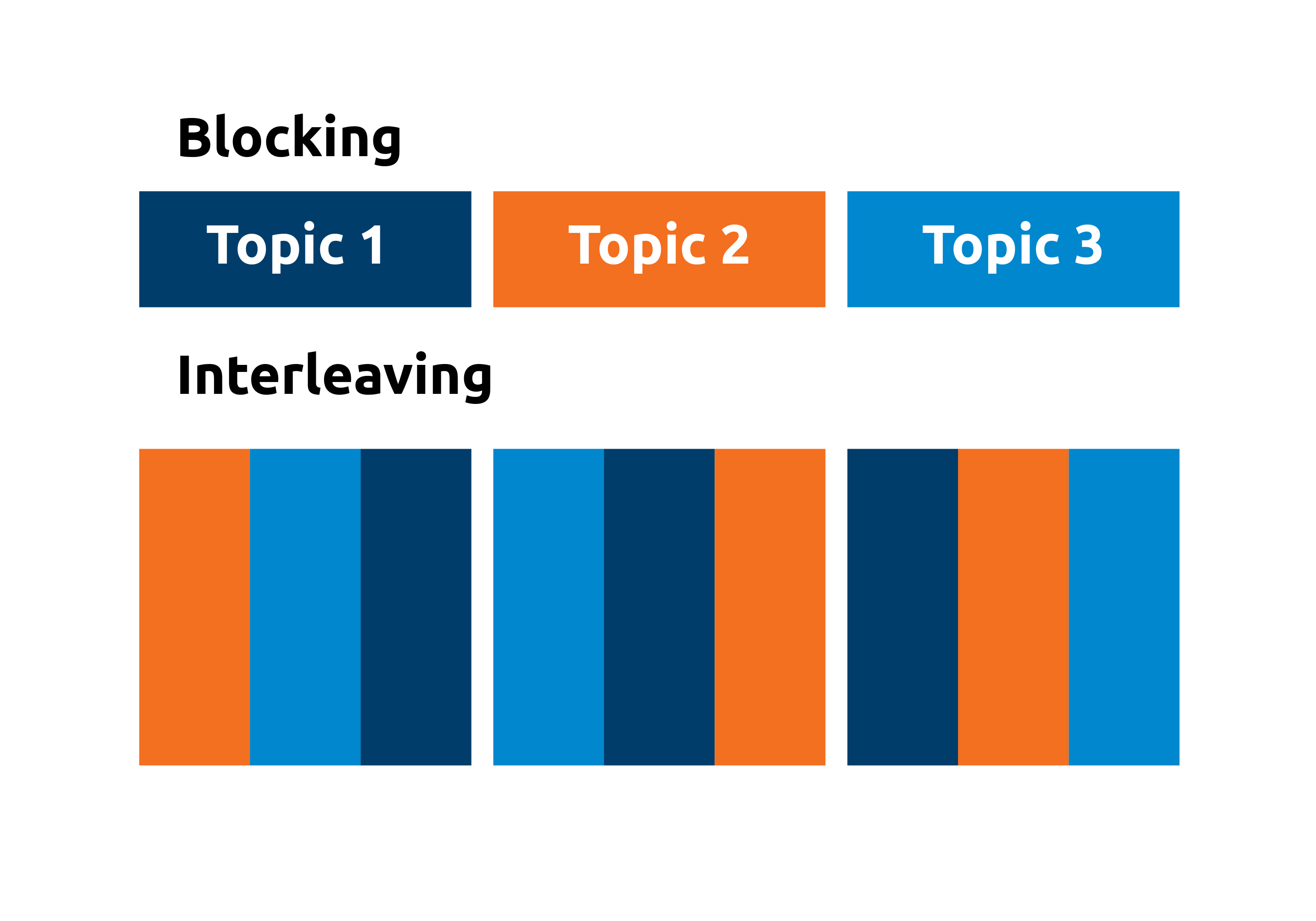Active Study Strategies
Many students study passively, but staying involved with what you are learning is needed so that you can take in all the information actively. Try incorporating some of the active study strategies listed below to help you engage more with the content so you can study for longer intervals and help you better understand and retain information.

Spaced practice involves spacing out your study time.
- Spreading out your study time is better than studying all at once.
- Schedule shorter blocks of study time to do a little bit at a time which will add up.
- Give yourself a break after class before reviewing the information.
- Review your class notes within the first 24 hours of learning the content.
- We should make sure that we review information regularly to keep it fresh in our minds.
- Make sure you are using effective study strategies rather than just re-reading your notes.
- Forgetting forces you to retrieve information from memory, which is how we remember and learn.
Check out the following article, which provides examples of how you could use spaced practice for different types of subjects.
Interleaving is a strategy that requires you to switch between topics while studying. With this technique, you go over topics in different orders to strengthen your understanding of the material and make links between topics.
The following videos provide an overview of how interleaving works:
To interleave effectively
- Decide on the material you want to mix up in your study session. Avoid items that are too similar and those that are too different.
- If the topics are too similar, the learning might become more of a blocked practice session.
- If the topics are too different, you might get distracted.
- Try to mix in old material with new material.
- During a study session, it can be helpful to add in older content. This helps make connections between materials.
Blocked Practice
Blocked practice is the act of studying a single topic and moving on only when it is fully learned.Here is a visual representation comparing interleaving and blocked practice:

Blocked practice can help build a foundation for learning but is not an active studying strategy. It does not challenge us to build upon what we have learned, or require us to make connections, like interleaving does.
For these reasons, interleaving is more effective: mixing things up makes learning more active.
Interleaving advantages and challenges
This interleaving process may feel difficult to do, and it might take a bit of time to implement. However, we learn and retain more information when we switch between ideas.
When writing exams, we won’t necessarily have all of the information presented to us in a straightforward, chronological order, so interleaving helps us prepare for the exam.
With interleaving you have to ensure you are not switching too often and are making enough time for each topic to be properly learned. You also need to make sure you are not switching just because a topic becomes difficult. Make sure you understand a topic before moving on.
Elaboration involves explaining and describing ideas in detail. It is particularly effective when we ask questions to help us connect prior knowledge with the new information we are learning. The goal is to make connections among ideas that we are trying to learn and make associations by reflecting on how the material connects with our own experiences.
To use the elaboration technique
- Ask questions about the material you are studying and reflect on how it connects to what you already know.
- Ask how things work and why.
- Make connections between different ideas and explain how they work together.
- Try to compare and contrast different ideas.
- Reflect on how the ideas you are studying apply to your own experiences.
Megan Smith and Yana Weinstein from the Learning Scientists provide a set of questions to ask yourself while studying and show you how to apply the technique to different subjects.
Here are their suggestions of questions you could ask:
- How do things work and why?
- How does x work?
- Why does x happen?
- When did x happen?
- What caused x?
- What is the result of x?
- What is the relationship between x and y?
- How to x and y compare and contrast?
- How are x and y similar and different?
- Why is x important?
- How could x be used to y?
- How does x tie in with what we learned before?
The concrete examples study strategy involves using specific examples to understand abstract ideas.
The following video explains how we can use this technique:
Where can we find examples?
- Collect examples your teacher mentions in class.
- Search your textbooks, notes, and other classroom materials.
- Look out for examples around you, sometimes, we find examples in our own experiences.
- Share examples with friends.
Creating relevant examples will be helpful for learning, if possible, always verify your examples with a specialist, peer tutor, TA, or instructor.
To use this technique
- Look over your class materials and find the visuals. Compare the visuals to the words.
- Look at the visuals and explain in your own words what they mean.
- Take the information you are trying to learn and draw visuals to go along with it.
Cognitive overload can occur if there are too many representations of the material, so use the strategy strategically. Ask yourself:
- What am I struggling to remember?
- What is the key idea I am expected to take from this lesson?
- Is there a way to represent this information differently, either in text or visual form?
By actively repurposing information into other forms, we engage our brains and build connections to help us better remember the information!
There are ways to optimize this strategy for our benefit.
To use this technique
- After you have gone through a set of lecture slides, your notes, and/ or the textbook, put them aside.
- Without looking at the materials, write down or sketch everything you know. Be thorough.
- If you are short on time and cannot re-write all your notes, cover your notes, attempt to recall aloud, and then uncover and check; this is called the copy-cover-and-check method.
- In effect, you are giving yourself a practice test when you try to retrieve information.
- Some information will come to mind, while other concepts may be more difficult to recall, focus your studying efforts on those areas.
- Once you are done, check your class materials for accuracy. Identify any important points you may have missed.
- Some other retrieval strategies involve:
- Taking as many practice tests as you can find.
- It can also be very helpful to make your own practice tests and trade them with a friend.
- Visit the Making Your Own Practice Tests page for some tips.
- It can also be very helpful to make your own practice tests and trade them with a friend.
- Making flashcards.
- Be sure to Practice recalling the information on them and see if you can go beyond the basic definitions by thinking about the links between different terms.
- Visit the Making Your Own Flashcards page for some tips.
- Taking as many practice tests as you can find.
Retrieval is hard: take it in steps
Remember, retrieval practice is hard to do! Take little steps and work your way up to recalling information on your own with the class materials closed.
- Start with a small section.
- If you aren’t sure about the content you are retrieving, take an educated guess and then go back and check for accuracy. If you were wrong continue studying it.
- Practice increasing what you retrieve, taking in only small chunks of information can be ineffective over time. We want to challenge our brains to connect back to the information we are learning so we can recall it when we needed.
- Retrieval practice works well with spaced practice. Retrieval practice is even more effective if done in short bursts over time, rather than in a single long session. This spacing causes us to forget some of the material, and the struggle to recall information strengthens our long-term learning.
References and Other Resources:
Gonzalez, Jennifer. (24 September 2017). Retrieval Practice. The Most Powerful Learning Strategy You’re Not Using. Cult of Pedagogy. Accessed at: https://www.cultofpedagogy.com/retrieval-practice/
Interleaving: How Mixed Practice Can Boose Learning. (n.d.). Effectiviology. Accessed at: https://effectiviology.com/interleaving/
Pan, Steven C. (4 August 2015). The Interleaving Effect: Mixing It Up Boosts Learning. Scientific American. Accessed at: https://www.scientificamerican.com/article/the-interleaving-effect-mixing-it-up-boosts-learning/
Smith, Megan and Yana Weinstein. (7 July 2016). Learn How to Study Using… Elaboration. The Learning Scientists. Accessed at: https://www.learningscientists.org/blog/2016/7/7-1
Stenger, Marianne. (9 September 2016). Interleaved Practice: 4 Ways to Learn Better By Mixing It Up. informED Open Colleges. Accessed at: https://www.opencolleges.edu.au/informed/learning-strategies/interleaved-practice-4-ways-to-learn-better-by-mixing-it-up/
Sumeracki, Megan. (6 June 2019). Dual Coding and Learning Styles. The Learning Scientists. Accessed at: https://www.learningscientists.org/blog/2019/6/6-1
Wadsworth, William. (28 May 2021). Interleaved Practice 101: what really is interleaving and how to REALLY yse it in teaching and learning. Exam Study Expert. Accessed at: https://examstudyexpert.com/interleaving/
Weinstein, Yana and Megan Smith. Illustrations by Oliver Caviglioli. (n.d.). Six Strategies for Effective Learning [Tip Sheet]. The Learning Scientists. Accessed at: http://static1.squarespace.com/static/56acc1138a65e2a286012c54/t/57d03e7d59cc6867e7fe9e40/1473265277428/All-B%26W-Posters.pdf
